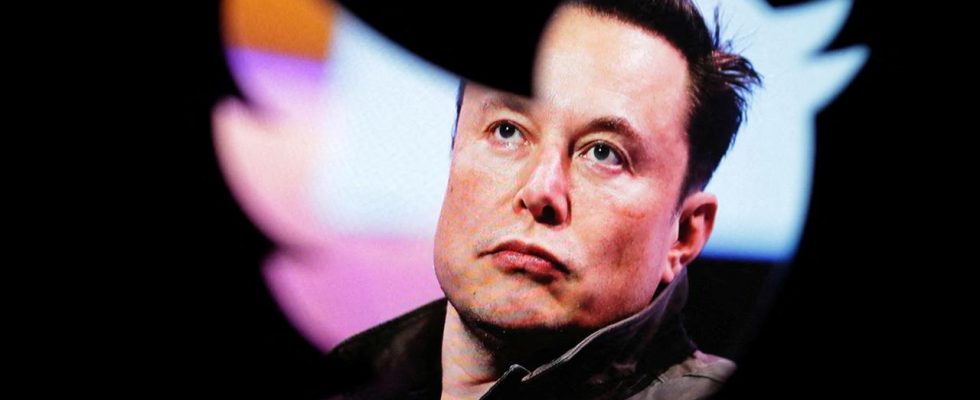“The bird is free,” Elon Musk tweeted six months ago. At the end of October 2022, the tech billionaire took over the short message service – and chaotic weeks followed. How is the platform today?
It starts with a sink. Elon Musk will be stepping into Twitter headquarters in San Francisco at the end of October. He carries a sink into the lobby. He posts a video of it and writes: “Let that sink in” – a play on words that means in a figurative sense: “Pull that in”, but literally translates to “Let the sink in”. Not all of the employees find this funny, many have to leave shortly after this tweet.
The staff
Much of the workforce has been laid off. Before the takeover, around 7,500 people worked at Twitter worldwide, now there are said to be 1,500. Musk has that in one BBC– Interview said in mid-April.
Former employees complain about the circumstances of the layoffs; many are logged out of their programs without warning. A worker group is suing Twitter for failing to comply with the notice periods required by the state of California.
The technique
In the past few months there have been many technical errors, failures and glitches. Many employees responsible for the technical maintenance of the platform have been laid off. In addition, Musk has repeatedly called for technical innovations that were introduced quickly and without extensive testing.
The freedom of speech
It is Elon Musk’s big topic: Because he saw freedom of speech on Twitter as threatened, he said he took over the platform. includes for him freedom of speech also extreme positions. Thousands of accounts previously banned from Twitter for hate speech or other violations are back online.
The most prominent Twitter account is that of Donald Trump; however, it hasn’t smelled again since it was activated. Trump prefers his own short message service, the Truth Social platform.
Former and current employees report that content moderation has hardly taken place at all or not at all since the takeover. The result – as shown by various studies – is false information, hate speech, anti-Semitic and extremist posts. They have increased in the past six months. In the BBCinterview, Musk denied that.
The blue and white ticks
The little tick was originally introduced to mark the authenticity of accounts. It should be immediately clear: This celebrity, this politician, this medium, this police headquarters are real. The ticks were not for sale.
However, almost all of the checkmarks that were originally given have recently been removed. Everyone can now have one and has to pay for it: private individuals around ten euros a month, companies get a golden tick for around 1000 euros a month.
The real problem: It is no longer reliably checked whether the account is actually real. Fake accounts that have spread false information have surfaced time and time again. Authorities, ministries or members of the government are marked with a gray tick that cannot be bought.
The money
Backed by investors, Musk paid $44 billion for Twitter in September. The value of the company has now halved. Technical failures, racist or inflammatory tweets and insecurity caused by fake accounts are not a good environment for advertisements. Large companies such as Volkswagen and General Motors have paused their spending on Twitter.
Twitter no longer publishes official figures, but according to market observers, advertising revenue has fallen sharply. According to an analysis by “Insider Intelligence”, in 2023 they should be 28 percent lower than in the previous year. In addition, there are high costs due to various court proceedings.
At the same time, there seem to be few who want to pay for Twitter ticks. It was involuntarily awarded to celebrities such as the writer Stephen King or the basketball player Le Bron James. They even fight back, not wanting to be perceived as allegedly paying supporters of Musk.
Accounts that were blocked for hate speech and then reactivated after his takeover could help Elon Musk. They sometimes reach millions of people. The non-profit organization “Center for Countering Digital Hate” has calculated that ten of these accounts with the widest reach bring advertising revenues of around 19 million dollars per year.
The credibility
Twitter has lost a lot of its reputation – and not just because of the chaotic check mark decisions. In the meantime, accounts of the BBC or the US radio network NPR misleadingly labeled as “government funded”. These notices have since been removed. NPR has since stopped using Twitter because the network felt its credibility was under threat.
The federal government is concerned and is monitoring the situation, said a government spokeswoman in Berlin. Many German media are also still on Twitter. Press inquiries have been answered with an automated e-mail for weeks. It contains only one character: the poop emoji.
The future
Twitter under Musk has experienced a chaotic half year. Above all, the decisions about the ticks have lost a lot of trust; Twitter seems increasingly unreliable. There are still many users. Alternative platforms like Mastodon have grown, but are still relatively small compared to Twitter. The big bang feared by many has so far not materialized – Twitter still works in principle.
So far, however, there is little evidence that Musk will change his chaotic leadership style. That’s why Twitter is currently in a pretty shaky position. Observers occasionally compare Musk’s service to a ship that is slowly sinking. It will be decisive when normal users, politicians, authorities and the media jump into the lifeboats.

